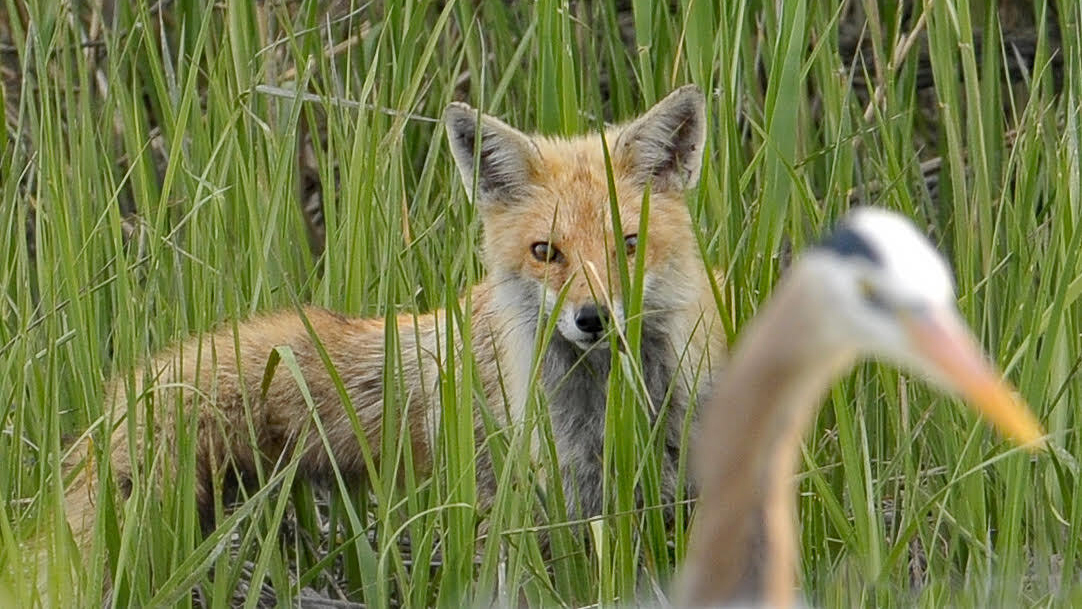Alien-like photo shows eel dangling out of heron's stomach in midair
It's possible the heron survived. The eel … likely not.

Update, Dec. 17 at 2:40 pm EST: Live Science has learned that the animal dangling from the heron is an American eel (Anguilla rostrata), not a snake eel. American eels are common in Delaware waters and along the U.S. Atlantic coast, according to the Delaware Department of Natural Resources and Environmental Control (DNREC). "It is rare for a heron to swallow an American eel that big and even rarer for the eel to burst out of the heron," a DNREC fisheries biologist told Live Science.
The original story, posted Nov. 10, is below.
A snake eel fighting for its life pulled an "alien" move by bursting out of the stomach of a heron that had just swallowed it whole, according to photos snapped by an amateur photographer in Delaware.
The photos show the snake eel, its head dangling in midair, as the heron — looking surprisingly unbothered — flies onward.
The unusual event attracted a lot of attention among the local predators, said Sam Davis, an engineer from Maryland who took the photos on the Delaware shore. Several juvenile eagles and a fox were following the heron, possibly hoping to scavenge a meal in case the heron or the snake eel didn't make it, he said.
Related: 15 of the largest animals of their kind on Earth
When Davis first spotted the bizarre flight, he thought that a snake or eel had bitten the heron's neck. Davis was about 75 yards to 100 yards (68 to 91 meters) away from the animals, but he had a telephoto lens for long-range photography, and so he shot photos as he watched the heron fly about and even land in the water with the eel still attached to it. "The heron didn't seem to act much differently," Davis told Live Science. "It was in the water and flying around."
Get the world’s most fascinating discoveries delivered straight to your inbox.
Meanwhile, the eel was arching its body, "so i guess it was still alive at some point," he said.
It wasn't until Davis returned home and edited the photos that he realized that the snake eel wasn't biting the heron. After enlarging the photos, "I could see the eel, you could see its eyes," he said. "It was actually coming out the other end" — headfirst.








The photos show "a pretty amazing sight," said John Pogonoski, an ichthyologist with the Australian National Fish Collection at the Commonwealth Scientific and Industrial Research Organisation (CSIRO), who wasn't involved with the heron and snake eel's encounter. "I would think this is either very rare or very rarely seen in a bird species, at least as far as I am aware."
Earlier this year, Pogonoski and his colleagues published a study in the journal Memoirs of the Queensland Museum on snake eels (a fish from the family Ophichthidae), detailing how snake eels can burrow out of the guts of fish that prey on them. "But usually they don't get very far," he told Live Science in an email. Once swallowed, snake eels can use their hard heads or tails to bust out of the digestive tract, but usually end up in the predator's body cavity, muscle tissues or swim bladder. Once trapped, snake eels often "become 'mummified' or 'encysted' [closed up in a cyst] and die rather than escape," he said.
In one instance, "a co-author of the paper once discovered a live snake eel inside a fish he caught when he cleaned the fish to eat it," Pogonoski said.
Davis never learned what happened to the heron and snake eel photographed in Delaware in 2011 (he uploaded the photos to a wildlife site only a few months ago). When he left the shore, the heron was still flying around with the snake eel hanging below it.
According to Pogonoski, "the heron possibly survived, it didn't look too inconvenienced, but would depend on how well the wound healed and if it was able to avoid an infection."
As for the snake eel, it "would only have survived if it was dropped over or very close to water with a salinity it could normally tolerate," he said.
Originally published on Live Science.

Laura is the managing editor at Live Science. She also runs the archaeology section and the Life's Little Mysteries series. Her work has appeared in The New York Times, Scholastic, Popular Science and Spectrum, a site on autism research. She has won multiple awards from the Society of Professional Journalists and the Washington Newspaper Publishers Association for her reporting at a weekly newspaper near Seattle. Laura holds a bachelor's degree in English literature and psychology from Washington University in St. Louis and a master's degree in science writing from NYU.
 Live Science Plus
Live Science Plus





